 |
Articles By Dr. Worell
CURRENT TRENDS IN AVIAN PEDIATRICS
Amy B. Worell, DVM, ABVP-Avian
Avian pediatrics, is a broad term that can encompass a large number of sub entities, including selection of breeders, incubation of eggs whether artificially, through foster parents or with the parents, incubator hatched as compared to parent reared and pulled at a variety of times for hand feeding, infectious diseases of neonates and problems encountered during the neonatal period, and weaning and socialization, to name a few. As the topic is quite broad, this paper will focus on the veterinary aspects of avian pediatrics in today's recession based economy in the United States. Information for this paper was obtained from the author's personal experience as both an aviculturist and an avian veterinarian, a review of current literature, and an email survey sent to numerous colleges. The information presented here is hopefully an accurate reflection of the state of avian pediatrics as is experienced in daily veterinary practice.
Trends as Reflected by the Numbers
The 1980 and 1990s produced a large number of individual aviculturists that were interested in breeding and raising birds for resale and pleasure. Such that depending on one's location in the country, the client base of veterinary clients owning birds in that area, and one's personal interests, certain practitioners could see a large number of avian patients. While the majority of these birds were psittacines, many passerines, ratites, and other species were raised as well. This increase and interest in aviculture resulted in large numbers of baby birds being produced that often required veterinary care and intervention. (Figure 1) In addition to baby birds being presented for a variety of health issues associated with management and non-management disease issues, so were the breeders presented for sex identification most frequently through use of an endoscope, and a mired of other health concerns. Baby birds, breeding stock and pet birds were commonly seen in many veterinary practices where a veterinarian demonstrated an interest and knowledge in avian species. (Figure 2, 3)
Fast forward to 2011. The country is in a stagnant recession or economic downturn, which has resulted in a number of changes in the veterinary field including that aspect dealing with avian species. Avian client visits and procedures are down as well as the variety of species seen, and the type of cases that are commonly presented. Generally speaking, gone are the days of large numbers of birds presented for devastating overwhelming viral infections (polyomavirus and PFBD for example), large numbers of aviculturist client birds, and baby birds of a large variety of species. (Figure 3) Replacing those avian presentations of the past is the avian veterinary practice that more commonly handles pet birds, many of them aging older imported birds. The variety of species is severely limited to a small number of species of finches, conures, amazons, cockatoos, and macaws, with a steady flow of budgies and cockatiels.
In corresponding with a number of avian veterinarians, the majority of which practice in the United States, the overall comments reflect what the author experiences in daily practice, which is a slowdown in avian patients as a whole and in particular, a slowdown in the number of avian pediatric cases which are presented.
Looking specifically within a recent time frame of the last five years, the comments vary from "significantly less", to "almost never", to overall percentages of decrease estimated to be from 60 to 90% less than in the previous five years. These numbers are not surprising in light of the downward trend of aviculturists actually raising birds, in light of the aging population of many breeding stock(1), in light of the dramatically decreased number of imported birds available at relatively speaking "low prices", and the down swing in the economy as a whole.
Trends as Reflected by the Source
Prior to the last five years or so, a large number of baby birds came into the pet trade through breeders and private aviculturists. There was a significant secondary channel that involved bird specific pet stores, that either raised their own baby birds for sale, purchased them from a multitude of private aviculturists or pet bird hobbyist, or, a combination of the two. Thus, the source of baby birds for the pet trade in particular, and for a lesser demand for the aviculturist for future breeding stock, has been from the aviculturists and the backyard breeders. The situation today is greatly changed. Many aviculturists have given up their avocation due to the commitment required of their time, expenses needed to continue and maintain populations of birds, loss of ready markets to sell the baby birds and adults, and the implications and realities of the 365 day per year commitment.
Today's avian veterinarian tends to see more baby birds that are sold through the large chain pet stores (Petco and PetSmart) as compared to baby birds being procured from a private breeder or large scale aviculturists. Gone are many of the small family run bird specialty stores, and hence a source of baby birds for the pet interested public. This of course varies with the individual veterinarian and their specific location and clientele. But overall, this is a significant trend that is markedly different than as recent as five years ago.
Trends as Reflected by Categories of Pediatric Cases Seen
In the past, which for this discussion ranges from 5 to 15 years ago, certain avian pediatric disease presentations were common. These frequently would include entire clutches of baby birds being presented for crop burns, large die offs of handfed babies from polyomavirus, weaning difficulties such as a 9 month old blue and gold macaws (Ara ararauna) for delayed weaning, and bacterial and fungal overgrowths resulting in a variety of medical presentations. In the past, large numbers of baby birds with these types of conditions and others, would be presented to avian veterinarians for medical care and advice.
In a non-scientific survey of colleagues, the four main types of pediatric presentations that are currently presented to the avian veterinarian are (in alphabetic order): beak abnormalities, crop stasis, splay legs/angular limb deformities, and stunting/malnutrition problems. It should be noted that many of these discrete entities are not really discrete rather they may overlap. Lesser noted presentations include a variety of husbandry related problems, infectious diseases, crop burns, trauma and fractures, and post weaning behavior/socialization issues.
Beak abnormalities
The two most common beak abnormalities that are seen in avian pediatric patients are scissor's beak and mandibular prognathism. Scissor beak is a lateral deviation of either the maxillary or mandibular beak, while mandibular prognathism is a condition where the maxillary beak incorrectly fits inside the mandibular beak. These are generally considered to be developmental problems rather than congenital problems, and the cause(s) are unknown. Conditions that may precipitate these beak abnormalities include environmental parameters that include temperature and humidity variances, as well as techniques used during hand feeding. It is also possible that nutritional factors such as excesses or deficiencies of nutrients may be involved. Scissor beak is most commonly seen in macaw chicks, and mandibular prognathism is most commonly seen in cockatoo chicks. (Figure 4)
If these beak deviations are noted early enough in the developmental stages of the avian patient when the beak is still soft and pliable, daily manual manipulation may be sufficient to return the beak to a normal growth direction. If the beak deviation is severe or not dealt with or identified when the beak is still pliable, then surgical/prosthetic techniques may be required to correct the beak changes. (Figure 5)
Crop Stasis/"Sour Crop"
Crop stasis by definition, is delayed, slowed, or complete lack of the crop to contract and move the contents into the proventriculus. This inability of the crop to empty in the time that would be expected is often called "sour crop" because of the smell that may be emitted if certain bacteria or yeast are present in abnormal numbers in a delayed emptying crop.
Delayed crop emptying can be caused by a number of factors including specific problems in the crop itself, problems involving other organ systems as the primary abnormality, and environmental and management issues. These broad categories may overlap such that a management issue may result in a bacterial overgrowth or fungal growth problem in the crop. Factors that may be involved in baby birds with crop stasis include microorganism overgrowth, polyomavirus infections, systemic disease, foreign body ingestion, overfeeding resulting in crop stretching ,and hand feeding formula being fed too hot or too cold. Other husbandry related issues such as improper environmental temperature and humidity, thickness of the hand feeding formula and hand feeder inexperience can also contribute to crop stasis. (Figure 6)
Treatment of crop stasis varies but may include turning the baby bird upside down to empty the crop contents, removal of crop contents with a feeding needle or tube, changes in husbandry practices, increase in number of times the baby bird is fed with decreased volume at each feeding, use of a "Crop Bra" to support the over stretched crop, and anti-microbial therapy. (Figure 7, 8)
Currently, crop stasis is most commonly reported in cockatiels, but other affected species include African grays, macaws and conures.
Splay leg and Angular Limb Deformities (ALD)
Splay leg, which is also called spraddle leg, is a term that is used to describe legs that are splayed outward or laterally from their normal position underneath the body. This condition can involve one or both legs and can be mild or severe. Etiologies may include a number of factors such as a possible genetic tendency, developmental problems during incubation, substrate issues such that the bedding or substrate may not have allowed the bird adequate stability to hold its legs in an anatomically correct position, dietary imbalances leading to rickets with or without pathological fractures, and slipped gastrocnemius tendons. (Figure 9)
Depending on the severity of the splaying and the age at which the bird is presented for an examination, techniques for managing this condition include hobbling the bird's legs together with or without "snow shoes", placement of the bird in a small container where the legs cannot splay laterally, and suspending the chick in a hammock type of a sling with the legs hobbled together. (Figure 10, 11) These techniques may or may not be effective in correcting the splaying. Other birds may be presented at a later age when the bones are no longer growing or with such severity, that surgery may be required or euthanasia should be considered.
Angular limb deformity (ALD), which is sometimes called rotational leg deformity, is considered to be either a congenital or acquired condition such that the distal limb deviates medially or laterally from a normal anatomical position.( Figure 12, 13) This appears to occur when more weight is on one side of a growth plate than the other, resulting in the deviation. Commonly the rotation involves the tibiotarsal bones and is seen in rapidly growing baby birds. Angular deformities can also be seen in the femur and in the tarsometatarsus. Dietary imbalances and some of the etiologies resulting in splay leg may also be implicated in this condition. Surgical correction such as a rotational osteotomy with placement of external fixation may be necessary to correct or attempt to correct the deformity.
Angular limb deformities and splay leg are commonly reported in cockatiels, lovebirds, budgies, pigeons and doves, and African grays.
Stunting, Malnutrition, and Nutritionally Related Problems
Stunting and nutritionally related problems are a large category that encompasses many different presentation and situations. Stunting by definition, suggests that the growth rate is less than ideal and the end product is less than normal. Stunting is considered to be quite common, most commonly occurs in the first thirty days of life, and can be clinically manifested in a number of ways, including less than ideal or recognized daily weight gains, a large head that does not proportionally fit with the bird's body size, thin legs and feet, abnormal feather growth and patterns, and a general overall "poor doer".
Factors associated with stunting and malnutrition include husbandry issues that may involve issues with hand feeding such as inadequate consistency or volume of hand feeding formula, inadequate frequency of feeding and formulas that are fed at inappropriate temperatures. Many husbandry issues may actually be directly related to the experience or inexperience of the hand feeder. These issues make one realize that hand feeding birds is both an art and a science. (Figure 14, 15)
Probably the most commonly recognized birds with stunting issues have been macaws. Other species that are seen with some frequency include cockatiels, budgies and conures.
Other nutritionally related conditions can be seen including an imbalance in dietary elements such that metabolic bone disease or secondary hyperparathyroidism develops. This may occur when a commercial hand feeding diet is supplemented to theoretically improve the diet for the growing chicks. (Figure 16)
Lesser Observed Pediatric Problems
Crop burns, commonly caused by feeding hand feeding food that has been microwaved and/or is too hot, is seen less today than in days past. Food dribbling down the bird's pectoral region from a fistula in the damaged crop tissue is a hallmark of burned crop tissue. Surgical correction as well as a modification of hand feeding technique is required. (Figure 17, 18)
Infectious disease, in particular virus infections, were once commonplace and often rampart in avian nurseries and hand feeding operations. Today, the incidence is greatly diminished. Infections due to circovirus (PBFD: Psittacine Beak and Feather Disease) was once common in cockatoos, and is now only sporadically seen in lovebirds, and a variety of other psittacines. Polyomavirus (APV) is noted to be the most common infectious disease currently observed in pre-weaned baby birds, but even then, the incidence is dramatically decreased in many parts of the country. It can easily be considered the overall most devastating infectious disease that can affect a nursery. Polyomavirus can be seen in a number of psittacine species but most commonly today it is recognized in macaws, conures, eclectus and caiques.
Infections with a variety of bacteria, fungus and yeast are still sometimes seen in young avian patients.
Fractures and trauma are another category of avian pediatrics that is presented to avian veterinarians for care with some frequency. Sources of the trauma most commonly involve cage mates, birds other than cage mates, flying into objects, and falling from a raised surface. Additionally, improper wing trims are sometimes thought to be the culprit in some trauma situations. Care needed for the baby bird depends entirely on the presentation and extent of the injuries.
Post weaning and socialization issues often can be grouped together in a behavior category, which in recent years has become mainstream and significant in the avian community. So although this category is not under the traditional realm of veterinary medicine for avian patients, its inclusion in this discussion is paramount to the future betterment and enrichment of avian pediatric patients everywhere. For those avian pediatric patients that are lacking in proper socialization, it is thought that many of the common problems that occur in adult avian pets originated at a young age. These include common behavior issues such as incessant and continuous screaming, aggression, biting, abnormal fear, bonding to one person only, feather destructive behavior with or without self mutilation, inappropriate sexual/reproductive activity, and unnecessary stress in the bird's environment that can result in the development of medical problems. (Figure 19, 20)
Discussing behavior principles in depth is beyond the scope of this paper, but the basic idea is that the young avian subject needs to be taught behaviors that are desired with the use of positive reinforcement techniques, among others. To teach appropriate behaviors, one must at some level understand what is natural and instinctive behavior for a bird which very often is a flock member, if the individual was in its natural habitat. (3, 4) Birds that develop problem behaviors are often simply doing what they have learned in the past. Thus, the importance of early socialization of baby birds is paramount. Environmental stimulation or environmental enrichment, which can be presented in a number of forms, is crucial for the development of chicks that will be trusting, independent, curious, and without fear in the world in which they have been thrown, which is that of a companion for a human caretaker. Thus early socialization with environmental enrichment is considered crucial for the health and happiness of the companion bird. For the young avian individual, what better place to start than during the hand feeding, weaning and post-weaning stages of life.
Figure 1
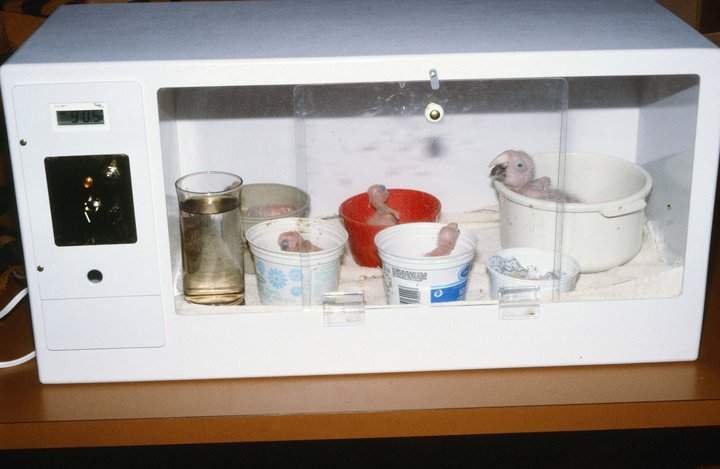
A collection of baby birds in an incubator when raising large numbers of babies was commonplace among aviculturists.
< Back To Article
< Back To Article
Figure 2
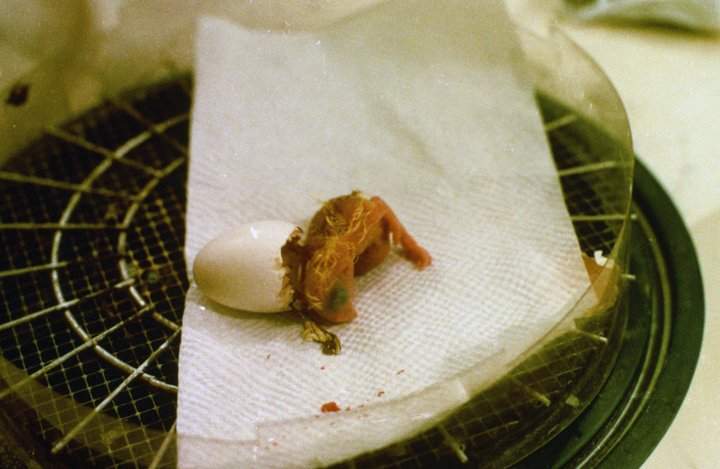
An incubator hatched baby which these days is more commonly replaced with parent reared babies.
< Back To Article
< Back To Article
Figure 3
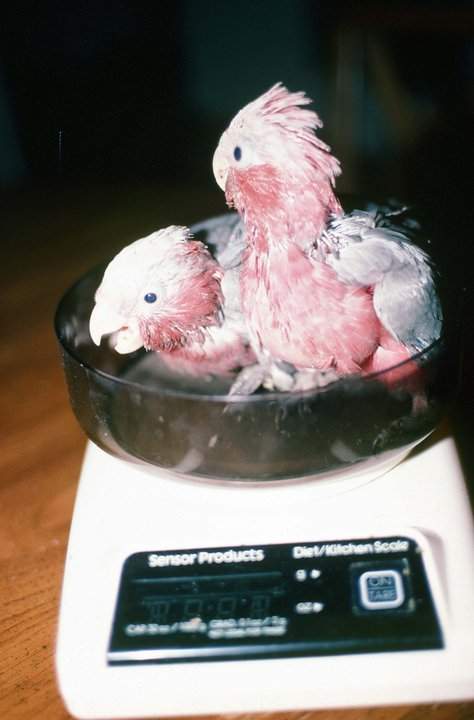
Species variety has greatly decreased such as with these rose breasted cockatoos babies. These birds are no longer common in the pet trade.
< Back To Article
< Back To Article
Figure 4
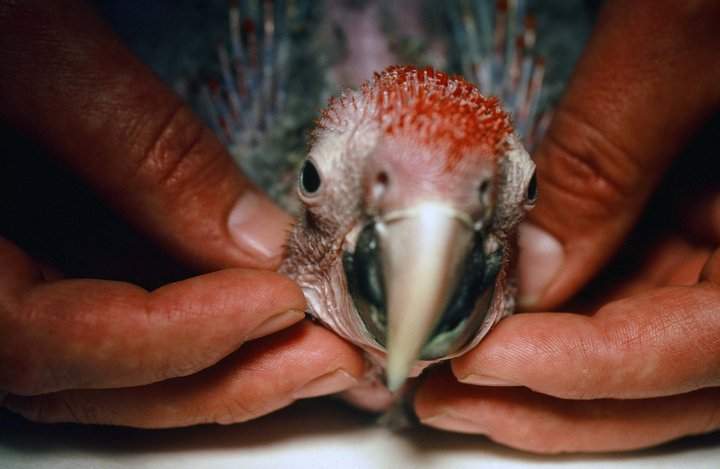
Scarlet macaw (Ara macao) baby with scissor beak. Rose breasted cockatoo (Eolophus roseicapillus) baby with a prosthetic attached for mandibular prognathism.
< Back To Article
< Back To Article
Figure 5
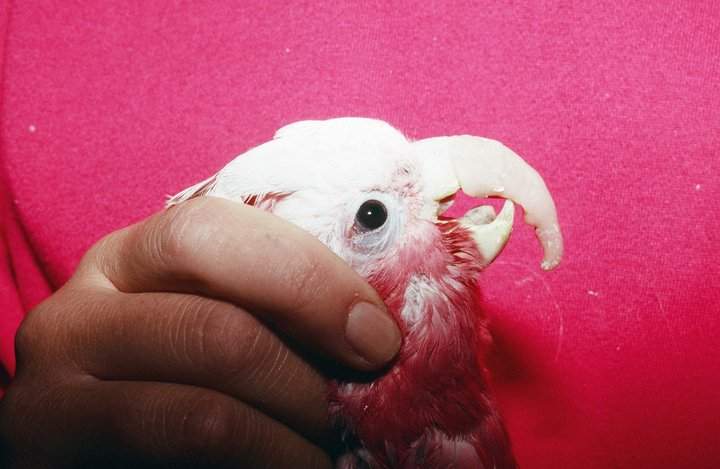
Rose breasted cockatoo (Eolophus roseicapillus) baby with a prosthetic attached for mandibular prognathism.
< Back To Article
< Back To Article
Figure 6
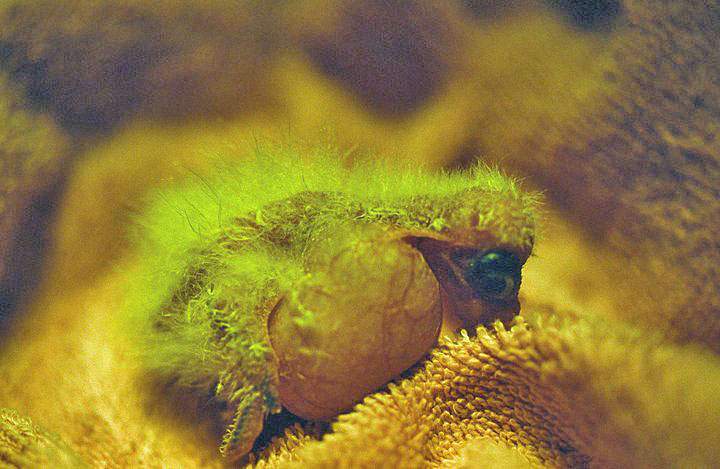
Baby cockatiel ( Nymphicus hollandicus) l with extreme crop stasis.
< Back To Article
< Back To Article
Figure 7
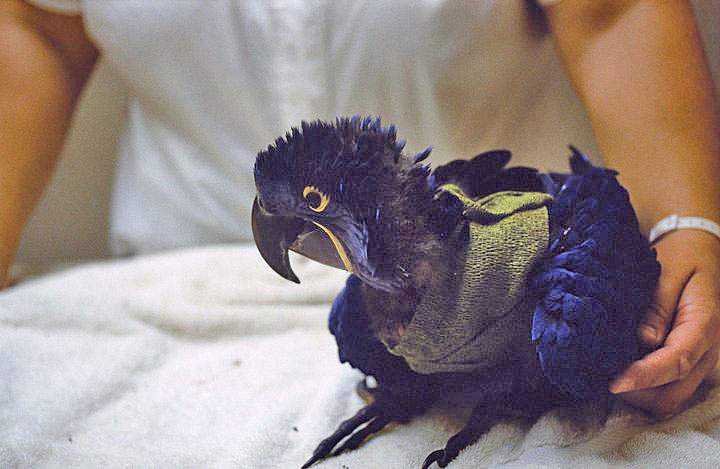
Baby hyacinth macaw (Anodorhynchus hyacinthinus) with a crop bra made from a coflex material.
< Back To Article
< Back To Article
Figure 8
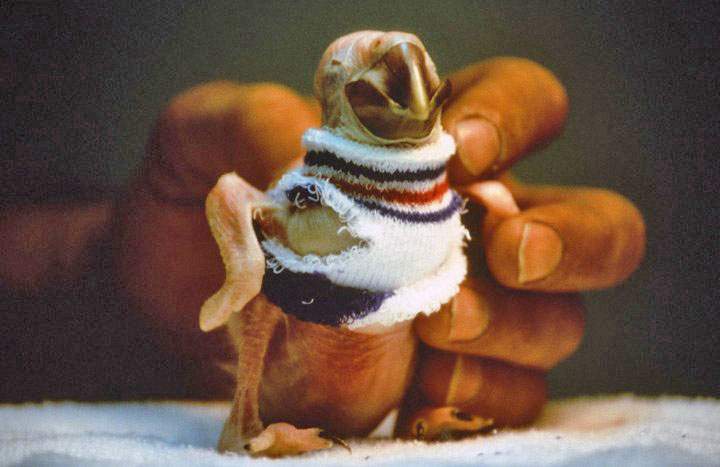
Macaw baby with a crop bra made from a sock.
< Back To Article
< Back To Article
Figure 9
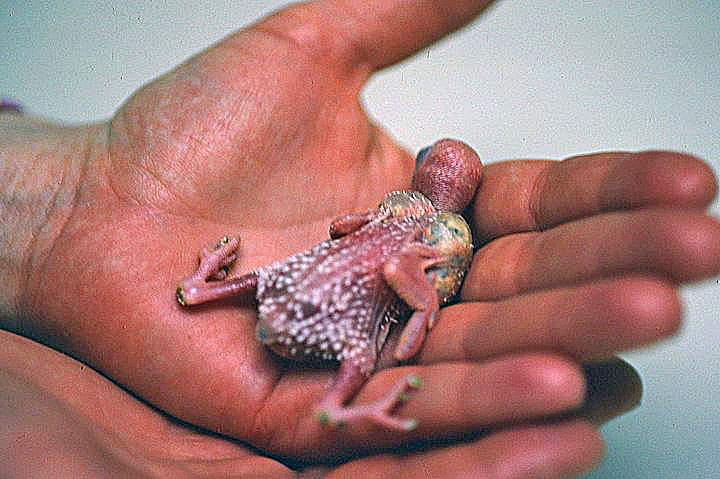
Spraddle or splay leg in a baby budgie (Melopsittacus undulates).
< Back To Article
< Back To Article
Figure 10
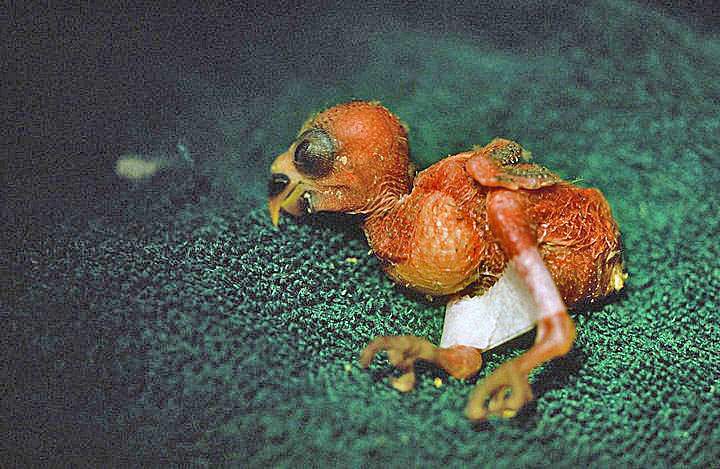
Baby bird with tape splint for spraddle leg.
< Back To Article
< Back To Article
Figure 11
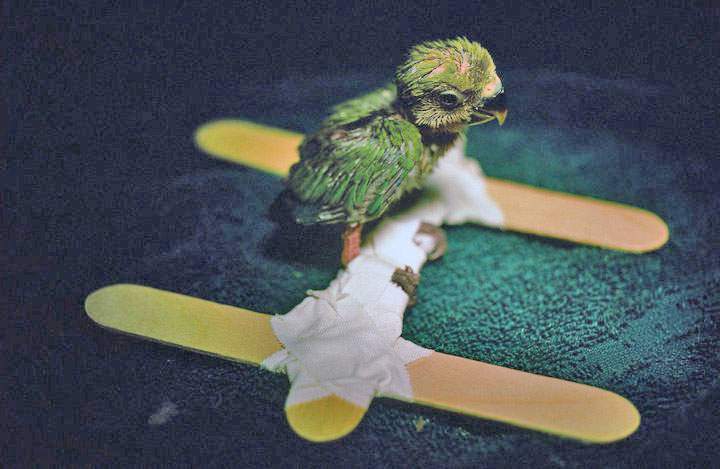
Baby bird with "snowshoe" tongue depressor support for splay leg.
< Back To Article
< Back To Article
Figure 12
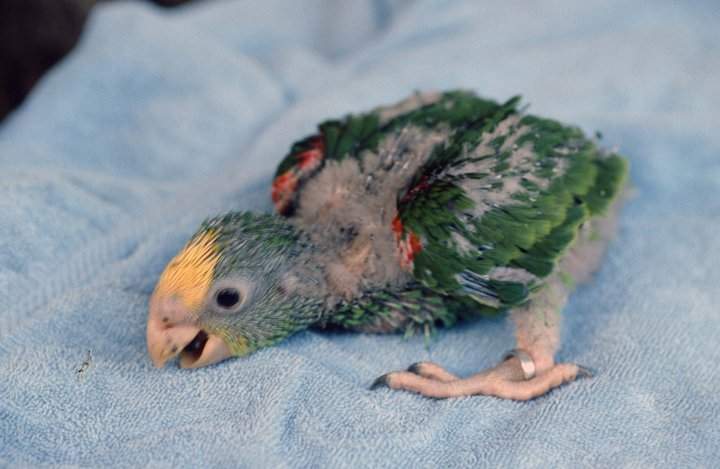
Angular limb deformity in the left leg of a young Double yellow headed amazon (Amazona ochrocephala orotrix).
< Back To Article
< Back To Article
Figure 13
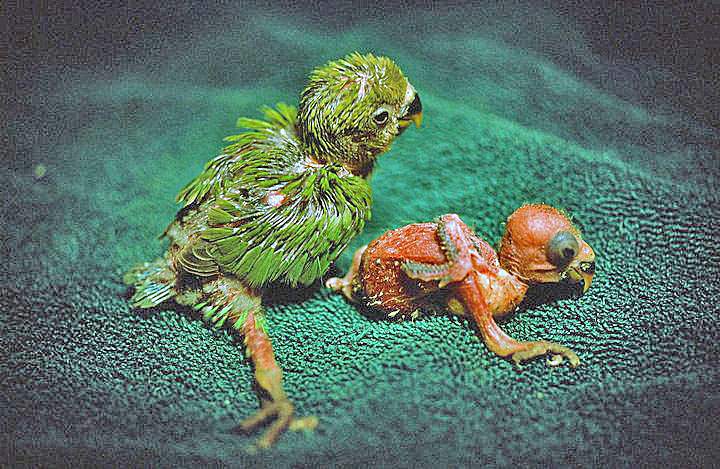
Angular limb deformity in a clutch of baby birds.
< Back To Article
< Back To Article
Figure 14
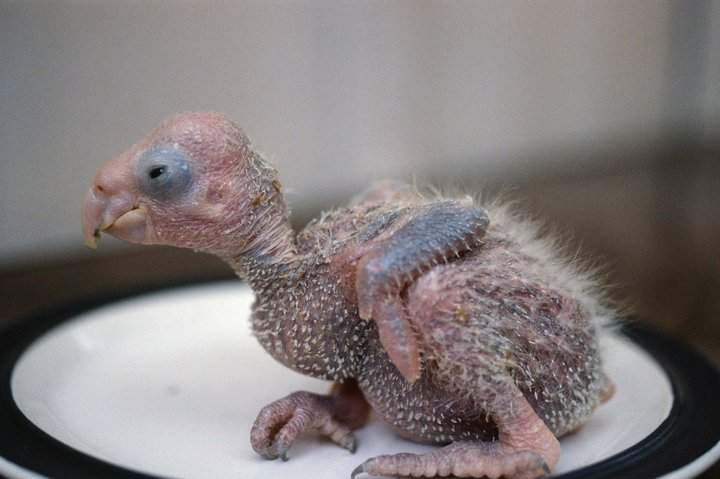
A healthy looking macaw chick. Note the plump legs, pink coloration, bright eyes.
< Back To Article
< Back To Article
Figure 15
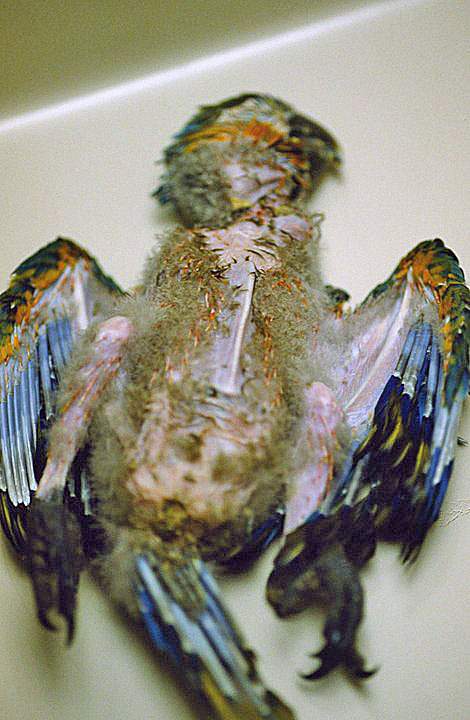
A young Catalina macaw (Ara ararauna X macao) that died of severe malnutrition.
< Back To Article
< Back To Article
Figure 16

Wing of a deceased male eclectus parrot (Eclectus roratus) that succumbed to severed metabolic bone disease.
< Back To Article
< Back To Article
Figure 17
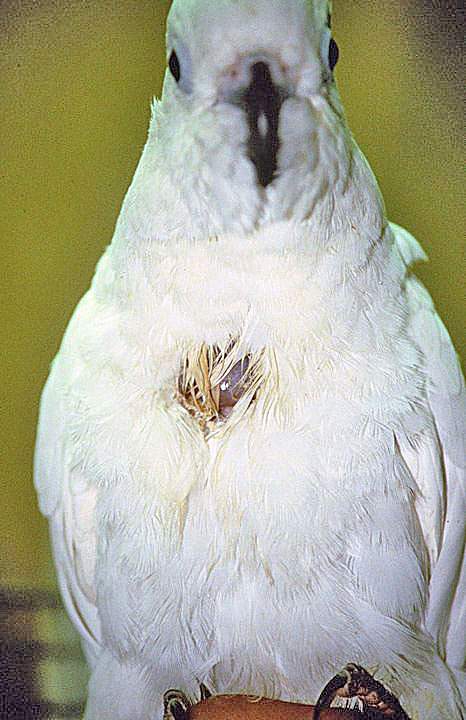
Crop burn from microwaved food. Note the fistula in the crop with food dribbling onto the feathers.
< Back To Article
< Back To Article
Figure 18
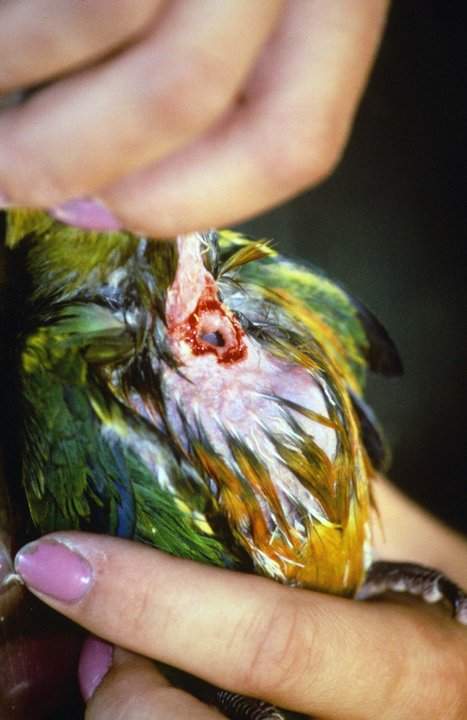
Crop burn with a small fistula prior to surgical repair.
< Back To Article
< Back To Article
Figure 19
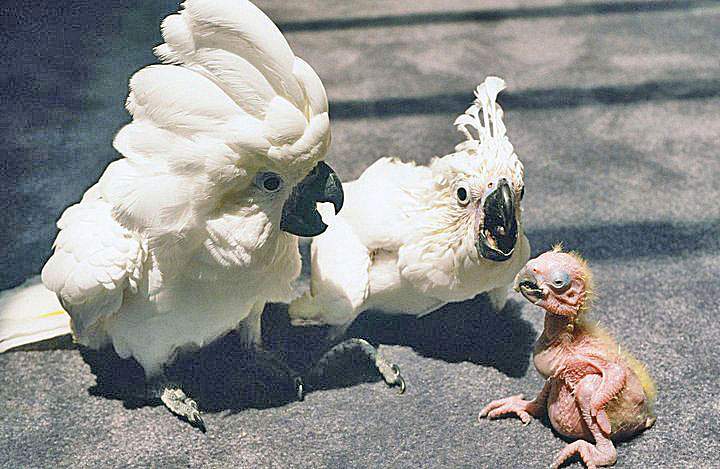
Three young umbrella cockatoos (Cacatua alba) that need daily socialization, at all ages, to produce well adjusted adult companions.
< Back To Article
< Back To Article
Figure 20
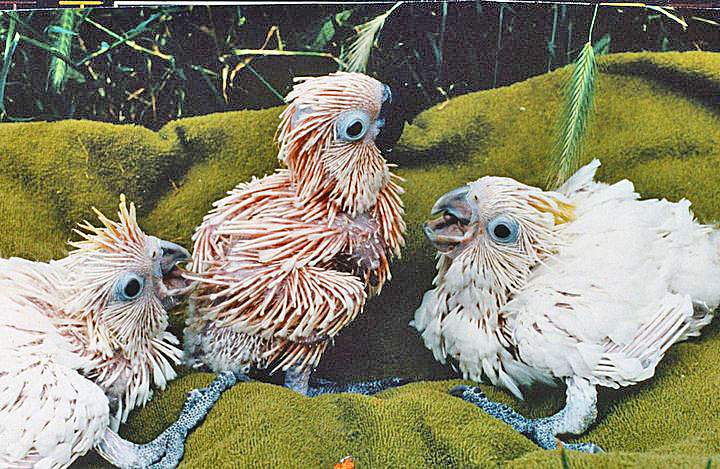
Triton cockatoo (Cacatua galerita triton), Moluccan cockatoo (Cacatua moluccensis), and umbrella cockatoo (Cacatua alba) babies. All these birds have a tendency to be very needy and loud. Early socialization will improve the chances that these babies will stay their lives with one family.
< Back To Article
< Back To Article